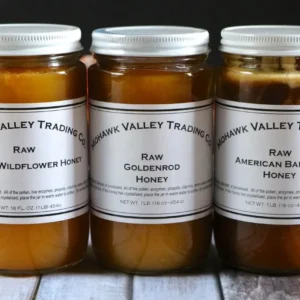Honey
If honey is to be used for its health benefits, it must be unfiltered, raw honey as heating and filtering honey destroy the pollen, enzymes, propolis, vitamins, amino acids, antioxidants, and aromatics.
Mohawk Valley Trading Company honey is raw and unfiltered. It is in the same condition as it was when it was in the hive.
We specialize in unfiltered raw, varietal honey, which is made primarily from the nectar of a particular type of blossom or flower. To capture the unique character and flavor of the blossom or flower, beekeepers must study botanical bloom and flowering patterns when planning hive placement.
No pesticides or herbicides are used in our apiaries. Although it is not labeled or certified organic, raw honey from the Mohawk Valley Trading Company is as organic as any produced in the USA.
Here are a few words about our honey from one of the world’s most renowned chefs Tom Colicchio:
“If you’re looking for really great honey, here’s my first piece of advice to you: You’re unlikely to find it in a plastic squeeze bottle shaped like a bear.
My second piece of advice: Try these raw honeys from Mohawk Valley Trading Company. Raw honey is unfiltered, unheated and totally unprocessed, and contains all of the same pollen, enzymes, vitamins, antioxidants, minerals, aromatics, and amino acids that it had while still in the hive. I’m told that raw honey has all kinds of health benefits, but I love it because I think it tastes exactly as honey should and has a wonderful, spreadable consistency and a slightly crunchy, substantial texture.”
Not only do we use raw honeys from Mohawk Valley Trading Company at Craftbar, ’wichcraft and Colicchio & Sons, but I keep a jar of the stuff on my desk at all times.”
-

Raw Honey
$22.00 – $40.00Price range: $22.00 through $40.00 Select options This product has multiple variants. The options may be chosen on the product page